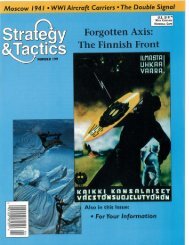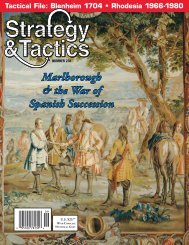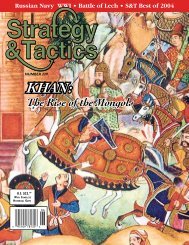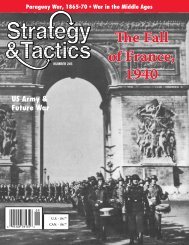the franco-prussian war - Strategy & Tactics
the franco-prussian war - Strategy & Tactics
the franco-prussian war - Strategy & Tactics
Create successful ePaper yourself
Turn your PDF publications into a flip-book with our unique Google optimized e-Paper software.
German ships have a reason for being out in <strong>the</strong>middle of <strong>the</strong> ocean - <strong>the</strong>y are stalking nine Britishconvoys attempting to go across <strong>the</strong> board during<strong>the</strong> time <strong>the</strong> Bismarck is out. As in <strong>the</strong> AH game, <strong>the</strong>two players move on separate boards and <strong>the</strong>n locateeach o<strong>the</strong>r or fail to do so with a calling out system.The major difference is in what happens when <strong>the</strong>two sides find each o<strong>the</strong>r. Then instead ofproceeding to <strong>the</strong> very abstract combat of <strong>the</strong> AHgame, <strong>the</strong> players here take out <strong>the</strong>ir cut out deckplans and proceed to a convenient floor to fight aminiatures-type naval engagement, using <strong>the</strong> sameor virtually <strong>the</strong> same system as Mr. Morale used inFlighr of rhe Goeben (Tactical Game) (082) andVictory at Sea (212). This system is moderatelycomplex in ship to ship actions and very simple for airattacks on ships. The strategic game includes aprovision for both sides refueling. The rules includethree hypo<strong>the</strong>tical situations ("what ifs"), all ofwhich give <strong>the</strong> Germans more ships to sally out with.115a. Salerno (1972, TMI, $4.00). by Vernon JayStribling, is a battalion-level game of <strong>the</strong> first landingon <strong>the</strong> mainland of Italy. The action takes place on aninvasion turn followed by seven days of two turnseach. The game is basically not difficult, but <strong>the</strong> rulesare in a disordered state and several areas are fully ofambiguities, especially <strong>the</strong> use of artillery. The victoryconditions are also ambiguous. There are no rulesregarding supply. It is a mildly interesting game, butanyone who plays it will have to spend some timediscussing and deciding on an interpretation of rules.The mapboard is black and white, reminiscent of oldPoultron Press (now SPI) games. The counters areattractive and die-cut but with a slight flaw in <strong>the</strong>cutting, so that each of <strong>the</strong> counters has to betrimmed to present a neat appearance. The game$includes many kinds of pieces (infantry, armor,reconnaissance, engineers, assorted artillery, commandos),with a few different powers. Thecommandos can land in special areas; <strong>the</strong> engineerscan move faster on roads (I'm not sure why); <strong>the</strong>anti-aircraft artillery can protect against air attack;<strong>the</strong> o<strong>the</strong>r artillery can fire at ranges from 6 to 14hexes. The game has some value, and is no doubt abetter effort than <strong>the</strong> o<strong>the</strong>r Salerno (115, MOVES#7), but it is still more unfinished than mostpublished games (again reminiscent of <strong>the</strong> old SPII.117. The Invasion of Sicily (1972, PzP, $4.00). byHarold Totten, graphics by Julie Lowry, is a 12 movebasically simple game dealing with <strong>the</strong> conquest ofSicily in July and August 1943. At 4 days per turn,<strong>the</strong> game lasts two turns longer than <strong>the</strong> originalcampaign. Taking <strong>the</strong> island is not sufficient for <strong>the</strong>allies to win <strong>the</strong> game since victory is determined bya lengthy point table. Most of <strong>the</strong> units are regimentsand each unit has two steps. The loss of one step isindicated by turning <strong>the</strong> counter over. There are sixwhat if situations which allow different set ups,invasion beaches, and reinforcements. The mapsheet is in four pieces which can be assembledwithout much trouble. The counters are, I believe,die-cut, although I have only seen a set with papersheets unmounted by <strong>the</strong> publisher.118. Rommel: The Campaign for Nonh Africa(1973, Sp, $5.50). by Loren Sperry, is a basicallysimple, but in its campaign form, quite a lengthytreatment of <strong>the</strong> <strong>war</strong> in Libya and Egypt. The gamebegins in September 1940 and proceeds, at <strong>the</strong> rateof 3 turns per month, to December 1942, for a total of84 turns in <strong>the</strong> long game. The game begins at <strong>the</strong>time of <strong>the</strong> Italian invasion of Egypt although <strong>the</strong>Axis player, since he knows true value of his army asprinted on his unit counters ra<strong>the</strong>r than <strong>the</strong>irapparent value in numbers of men, will usually startretreating on his first move. The units are divisionswhen possible, o<strong>the</strong>rwise brigades or smaller units.The game uses a step reduction and rebuildingsystem which resembles that used in Anzio withseparate counters representing replacements. TheAllies have a constantly changed order of battle asunits are withdrawn and reintroduced. There is asupply system for attacking and defending, but lackof supplies does not prevent but only slightlyweakens <strong>the</strong> attack. Oddly, <strong>the</strong>re is no way to deprivea unit of what is sometimes called "general supply."A unit will continue to move and attack at fullstrength even when completely surrounded. Combatsupplies, like replacements and reinforcements,arrive according to a schedule printed on <strong>the</strong> timerecord track. Also, both sides get some air powerfrom time to time. The struggle is faithfully portrayedin that <strong>the</strong> game turns into a see-sawing battle fromEl Alamein to El Agheila, unless a player is foolishenough to try to stand against a much stronger force.During many of <strong>the</strong> game's turns nothing muchhappens as <strong>the</strong> exhausted armies wait for newstrength to arrive on <strong>the</strong> field. In most ways, it is animprovement over AH'S Afrika Korps, except in <strong>the</strong>writing of <strong>the</strong> rules which leave several large areas ofambiguity. For those who don't have time for <strong>the</strong>long game; <strong>the</strong>re are four short games: on <strong>the</strong> Italiandefeat (15 turns), Rommel's first offensive (10 turns),<strong>the</strong> Crusader battles (12 turns), or <strong>the</strong> Battle ofGazala (6 turns). All of <strong>the</strong>se have separate victoryconditions and are quite playable and sometimesmore faithful to <strong>the</strong> original situation.119. Kasserine Pass (1973, CGC, $8.95). by JohnHill, presents <strong>the</strong> twelve day battle between Rommeland a mostly American force in Africa in early 1943 at<strong>the</strong> rate of one turn per day. It is a game much likeBattle of <strong>the</strong> Bulge, except that since <strong>the</strong>re is nosupply rule, <strong>the</strong> allies must stop <strong>the</strong> Germans headon. It is very difficult to do; impossible for <strong>the</strong> firstfew days as <strong>the</strong> German player enjoys <strong>the</strong>exhilaration of conducting a real blitzkrieg attack.Victory is decided by a simple point system. Theunits involved are mostly battali8hs. There areseveral kinds of units involved and a few functionaldifferences between units. There are also nationaldifferences: American and Italian infantry haveweaker zones of control than <strong>the</strong> o<strong>the</strong>r units. Artilleryfires at ranges of 2 to 4 hexes and can support a unitbeing attacked (as in 1918, ano<strong>the</strong>r similar game).The game allows several different lines of strategy tobe applied, and <strong>the</strong>refore, it is difficult to tell so earlywhe<strong>the</strong>r one or <strong>the</strong> o<strong>the</strong>r side has <strong>the</strong> edge. But JohnHill prides himself on producing evenly balancedgames and so far Kasserine Pass seems wellbalanced here. The board is attractively printed inthree colors on a light plastic board which isguaranteed forever by CGC. The counters (and ofcourse <strong>the</strong> hexagons on <strong>the</strong> map) are larger thannormal, well printed and die cut. The game is wellworth looking into. In addition to its o<strong>the</strong>r virtues itcontains a two die combat results table which allowssome very unlikely things to be included in <strong>the</strong>possibilities, for example, on <strong>the</strong> roll of a 12 (1 out of36 chance), a 1 to 2 attack will produce a defendereliminated. Of course, <strong>the</strong> chances are much betterthat <strong>the</strong> result will be attacker eliminated orsomething in between (contact, engaged, as in Barrleof <strong>the</strong> Bulge, retreats, or exchanges).137. Desrrucrion of Army Group Cenrer: The SovierSummer Offensive, 1944 (1973, SPI: SbT #36, $7.00for <strong>the</strong> boxed issue-game), by James F. Dunnigan,graphics by Redmond A. Simonsen, is for a time atleast <strong>the</strong> last of SPl's eastern front series which take<strong>the</strong> <strong>war</strong> from The Moscow Campaign through TheBattle of Sralingradand Kursk (<strong>the</strong> three having beenpublished in reverse chronological order) and now tothis game which begins on June 22, 1944, andproceeds by two-day turns to July 11. The gamemechanics follow closely those of <strong>the</strong> o<strong>the</strong>r games.The units are German divisions and Russian corps,but <strong>the</strong>re are no air units on ei<strong>the</strong>r side. The twoimpulse system for mechanized units is used to allow<strong>the</strong> possibility of breakthroughs or to force a defensein depth. The territory is large: from Vitebsk in <strong>the</strong>East to Warsaw in <strong>the</strong> West, and <strong>the</strong> advancingRussians have to cope with moderate to severesupply problems; but <strong>the</strong> objective in <strong>the</strong> game is toacquire points by killing enemy 'units not by takingterritory. This is fairly simple for <strong>the</strong> Russians in <strong>the</strong>historical game in which <strong>the</strong> German is set up in hisoriginal salient and is required to obey Hitler's orderto stand fast (for <strong>the</strong> first turn). So a number of"what-ifs" are brought in to balance <strong>the</strong> game: <strong>the</strong>Germans can pull out of <strong>the</strong> salient before <strong>the</strong> gamestarts or at least respond to <strong>the</strong> Russian attack moreintelligently. The result is varied. The Game is a littleeasier to work than <strong>the</strong> o<strong>the</strong>r games in <strong>the</strong> series andcan be mildly recommended to historians and garnersalthough <strong>the</strong> situation simply lacks <strong>the</strong> dramainherent in its predecessors.151a. The Invasion of France and <strong>the</strong> Barrle ofGermany (1972, Hi, $5.00). by Laurence J. Rusieoki,deals with Western Europe from June 1944 to March1945. In order to win a tactical victory <strong>the</strong> allies mustpenetrate into Germany past <strong>the</strong> Rhineland on <strong>the</strong>Ruhr. To win a strategic victory, <strong>the</strong>y must penetrateinto central Germany, which is off <strong>the</strong> board. Ei<strong>the</strong>rone is a very difficult task. The game is played mostlywith infantry corps and armored divisions. In manyways <strong>the</strong> game resembles Barbarossa. Each move isa month but a two-impulse movement system and<strong>the</strong> ability to overrun small forces allows <strong>the</strong>possibility of deep penetrations. These can beprevented only by a defense in depth. Forces notfighting can be shifted anywhere on <strong>the</strong> boardbehind friendly lines. Attacks need supply counterswhich are sometimes scarce for <strong>the</strong> allies. The gameis different from Barbarossa in that its combat resultstable is relatively bloody, but <strong>the</strong> bloodiness isbalanced by a high replacement rate which keepsmost of <strong>the</strong> allied units on <strong>the</strong> board most of <strong>the</strong>time. The German replacement rate is not quite sogenerous, but <strong>the</strong>y get many new units. This was oneof <strong>the</strong> factors which caused <strong>the</strong> allies to lose most of<strong>the</strong> games we played here, but <strong>the</strong>y always lost by sonarrow a margin that we couldn't be sure it wasinevitable. Almost all of <strong>the</strong> rules, including, ofcourse, rules for paratroops and two invasions, areclearly stated. Tactical air power restricts Germanmovement and allows <strong>the</strong> allies extreme advantagesin attack and defense, but only from June toSeptember. The Germans in our games were notfoolish enough to use <strong>the</strong> lack of allied air power (oranything else) as an excuse to launch a Decemberoffensive. This was ano<strong>the</strong>r reason <strong>the</strong>y were so hardto push back. But in spite of this difficulty, 1944 is asmooth, fascinating game. Two "mini-games" areincluded which offer <strong>the</strong> possibility of a 1942 or a1943 invasion (with altered victory conditions). Themap is multi-color, nearly as attractive as some SPImaps. The counters are professionally designed,thick, glossy and die-cut.152a. Omaha Beach (1972, Spartan 4, Sparta,$2.501. by Norman Beveridge, Jr., is a supplement toPanzerBlitz enabling <strong>the</strong> owner of that game to fight<strong>the</strong> D-Day sea and airborne landings. The playerneeds PanzerBlirz, from which he uses <strong>the</strong> boardsand <strong>the</strong> German counters. The kit furnishes eightmap sheets (each one half <strong>the</strong> size of a singlePanzerBlirz map section), six are beach areas, onefeatures a large flooded area, <strong>the</strong> last features a largenumber of hedgerows, which are also present on <strong>the</strong>beach area maps. These are combined with <strong>the</strong>PanzerBlitz boards to form <strong>the</strong> terrain for ninescenarios which cover every area of D-Day action.The Allied units are on two 8 x 11 sheets. Most of <strong>the</strong>units of course are infantry, paratroops, engineers,mortars, rangers; but <strong>the</strong>re are also someself-propelled guns and tanks, some of which areself-landing and o<strong>the</strong>rs of which are equipped withflails for clearing mines (with a little luck). There are afew extra German units: dug in forts, minefields, andseveral kinds of long-range guns. The rules used are<strong>the</strong> same as those of PanzerBlirz with only a fewextra rules to cover <strong>the</strong> new terrain and weapons,beach and parachute landings, and naval and airsupport for <strong>the</strong> landings. This is a very carefully donekit which shows a great deal about <strong>the</strong> D-Daysituation. Of course it is primarily an infantry andartillery grapple - <strong>the</strong>re are only eight Germanarmored fighting vehicle units in all nine scenarios.Never<strong>the</strong>less, this kit ought to be enjoyed by anyonewho appreciates PanzerBlirz.1533. Overlord: The Normandy Campaign (1972,CGC, $8.95). by John Hill, is a 28 turn game, in whicheach turn represents 3 or 4 days. At <strong>the</strong> beginning<strong>the</strong> allies are already on <strong>the</strong> beaches and must fight<strong>the</strong>ir way inland and off <strong>the</strong> board. The board coversan area of about 120 miles by 90 miles including <strong>the</strong>invasion beaches, Cherbourg, St. Malo, Avranchesand Argentan. The breakout from this area tookplace historically just after August 1, 1944. The gamegives <strong>the</strong> allies much more time, to <strong>the</strong> end ofAugust. The time will most often be necessary since<strong>the</strong> Germans are fortunately not subjected to a Hitlerrule to require impossible holding actions and.counterattacks. The campaign in <strong>the</strong> game is atough, closely fought, step by step advance through







